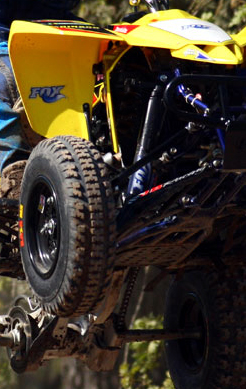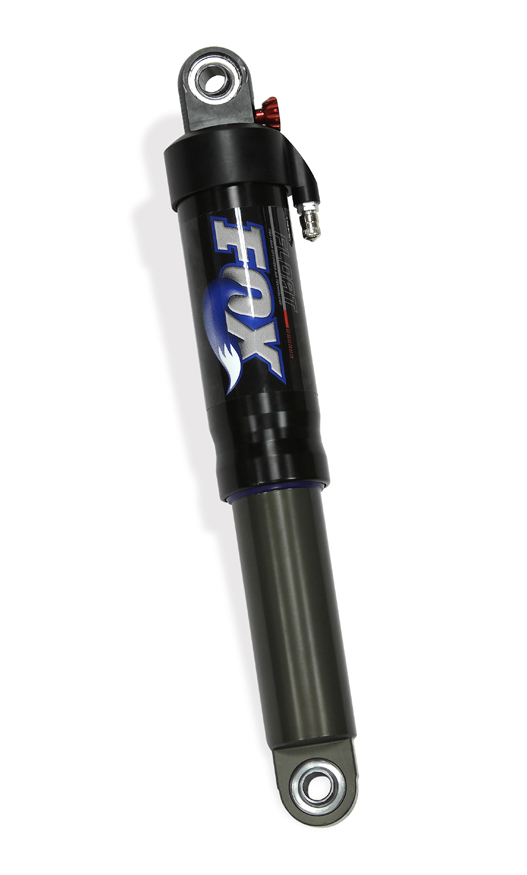Fox Float R Review
 It’s tough to imagine a company more involved in the off-road world than Fox Racing Shox. With aftermarket suspension offerings for everything from rally trucks to mountain bikes and everything in between, it’s really no surprise that the famous blue tailed logo has become synonymous with the dirt.
It’s tough to imagine a company more involved in the off-road world than Fox Racing Shox. With aftermarket suspension offerings for everything from rally trucks to mountain bikes and everything in between, it’s really no surprise that the famous blue tailed logo has become synonymous with the dirt.
Arguably their greatest success story centers on the rough and tumble world of mountain bike suspension due to industry-wide acceptance of the air-spring concept but Fox has been working diligently to perfect the technology for use in the ATV world as well.
For 2009 the company offers two unique air sprung options for sport/ performance ATV enthusiast and a single coil-over (physical spring) option for the rear (the remote reservoir-equipped Podium X).
In this review we will be taking a look at the more affordable of the two front shock options, the Float R. These units share many of the charms and tech features of the higher-end X Evol series but come in at roughly half the price. To come clean right from the get-go, we’re big fans of the Float X Evol and would recommend them to anyone with nearly ,500 spare change to drop on a pair of front shocks. Since this is the real world and times are tough for riders of all disciplines, we came into this test in the hopes of finding a shock that maintains the benefits of the high-end air-sprung units but at a much more realistic price point (0 per pair). Did we succeed in the Fox Float R? Read on to find out.
The Stare Down
Upon initial examination, the first thing that stands out about the Fox Float R, at least when compared to the OEM units we were swapping them with, is the lack of complexity to the shock’s exterior. The fact that the Float R lacks both an external metal spring and any sort of reservoir (remote or piggyback) makes this shock surprisingly compact and simplistic in its appearance. Mounting it on to our 2006 Suzuki LTR-450 was a non-affair as everything lined right up for bolting into place. The immediate realization is one of weight shavings as the stockers came in at a healthy six and a half pounds apiece. The Float R’s, even when fully pressurized, didn’t quite hit 2.5 lbs each- that’s an immediate eight-pound weight reduction and in the area of an ATV’s steering assembly, this will definitely be felt in action.
Dialing in the shock is as simple as adding pressure to the air spring (we ran 55 psi on the trails and pumped them up to 61 pounds for the motocross track). Fox calls their damping system VSDC or Velocity Sensitive Damping Control. SSS (not be confused with Kayaba’s Speed Sensitive System) stands for Samurai Sealing System. What this means in English is seals designed specifically for the extreme temperatures and rough conditions unique to ATV riding.
Other acronyms include IFP, which stands for Internal Floating Piston and IAAS for Infinitely Adjustable Air Spring. In order this means a piston suspended by air pressure within the shock body and, unlike a traditional oil damped shock, air springs can be infinitely tuned in based on air pressure alone.
Aside from having the ability to tweak the amount of pressure on the air spring, the Float R offers external rebound adjustment in the form of a small red dial above the air valve. Compression is preset from the factory.
The Ride
We know, we know- spec sheets and fancy abbreviations alone don’t necessarily make a great product. The truth of the Float R’s strengths and weaknesses would only be revealed in real-world conditions, which in this case meant sandy trails and a hard pack intermediate MX track.
The first thing our test riders noticed once the Floats were mounted up was the weight reduction. Eight pounds is quite a bit of weight to remove anywhere on a sport ATV’s chassis, even more so in the front where tugs on the handlebar and bursts of acceleration are used to loft the front wheels.
Suspension action could best be described as “airy” if you’ll excuse the bad pun. Fluid damping is known for its trait of requiring successive impact pressure to activate whereas the air-sprung units feel constantly active. Watching the shock in action confirms this feeling as the first quarter-inch or so of travel is perpetually working at absorbing all of the near-invisible terrain imperfections of the trails. Small bump sensitivity is remarkable.
The suspension’s mid range wasn’t quite as noticeably smooth as its early travel habits (which is to say is still easily on par if not slightly better than the performance of the stockers we removed), the next really impressive moment came once we got it to the track and took a few flat landings. Due to the fact that compressed air is far more progressive than the energy stored in a metal spring, the Fox Float R’s are much better suited at resisting hard bottoming. Air pressure allows for a smoother transition into the final inches of travel while at the same time provides additional resistance to metal on metal contact that accompanies reaching a suspension’ limits.
The only modification required to transition from trail to track was a few additional pounds of pressure pumped into the shock via the included pump and we sped the rebound up a few clicks for straighter tracking through the whoop sections.
Conclusion
While Fox states the Float R’s primary purpose as trail riding, there is little doubt that these units could certainly be pressed into competition duty for the budget-minded racer. The adjustability range of the air spring coupled to the external rebound adjuster results in a versatile product that absolutely excels in all conditions.
For more:

